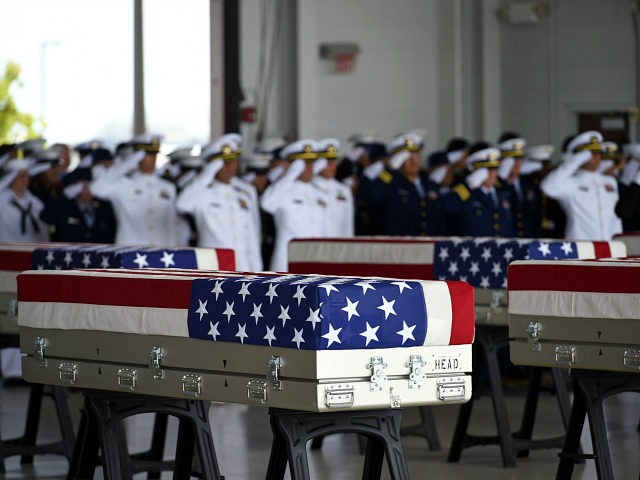American forensic scientists and military investigators may take months or even years to properly identify what is believed to be 55 sets of remains of U.S. Korean War veterans returning from North Korea this week, the LA Times explained in a report Thursday.
North Korean dictator Kim Jong-un agreed to return the remains of American soldiers that went missing or were killed in North Korean territory during the active hostilities of the Korean War, occurring from 1950-1953. Hostilities ended in 1953 with an armistice agreement, but the Korean War is still technically in vigor. Kim agreed to the return of the remains during his meeting with President Donald Trump in Singapore on June 12.
On Wednesday, the Pentagon welcomed what North Korea claims to be the remains of at least 55 people to Hawaii. Following their return, Dr. John Byrd, chief scientist of the Defense POW/MIA Accounting Agency, briefed reporters on the status of what they received from North Korea. He noted that preliminary review of the remains confirms that they are human and belong to Americans.
“All of the remains appear to be American. In some cases there are complete bones that in size and shape, I feel confident, are quite likely to be American,” he explained. “We’re going to begin DNA samples immediately. Any teeth will be immediately looked at.”
The structure of the complete bones appeared to be of European and African ancestry, which suggests they were Americans.
The Pentagon keeps a database of family DNA data for MIA American troops that forensics experts will use to match the remains to families. The LA Times notes that the U.S. government has DNA data for about 92 percent of those missing taken from relatives, as DNA testing technology did not exist during the active period of the Korean War. Some identities, Byrd warned, would be harder to piece together than others.
“Where we have matches, compelling matches with DNA, we will get a very strong lead and be able to pursue identifications quickly. In other cases it could be months or even years before we’re able to narrow down the identity,” he warned.
Byrd also praised the “high standard” to which the packaging and care of the remains was held on the part of the North Korean government.
The North Koreans sent only one dog tag home along with the remains. Pentagon officials have yet to publicly identify the name on the dog tag or confirm whether the remains sent home match that identity.
Fox News reports that the North Korean government sent the remains home along with a cache of items believed to have been found with the bodies, “including several pairs of boots, two helmets, several canteen bottles, dozens of buttons, buckles, a bayonet handle, socks and one pair of what appeared to be fingerless gloves.”
This most recent transfer of remains is far from the first from North Korea to the United States, and could well be far from the last. The Pentagon has identified 7,800 missing Americans in the Korean War, most believed to have died in North Korea, many in harrowing conditions in the nation’s detention camps. The number is a significant percentage of the estimated 36,000 that died in the war. Between 1996 and 2005, North Korea allowed the United States to send experts to find remains to 33 sites, according to the New York Times. Those missions yielded 229 sets of remains, most of which have not been identified. The missions stopped as the North Korean regime used the plan for profit, as it has often done with negotiations with the United States; they cost the United States nearly $20 million.

COMMENTS
Please let us know if you're having issues with commenting.